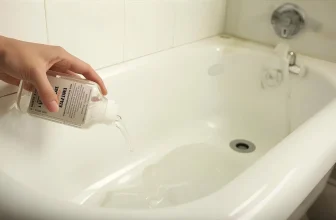How to Remove Chalk Paint (Your Ultimate Guide)

Chalk paint is a godsend for those who love DIY projects and painting. It’s easy to use, versatile, and gives a beautiful matte finish. But what if you make a mistake or simply want to change things? You may wonder how to remove chalk paint without damaging your furniture or walls.
Here in this guide, we’ll cover everything you need to know about removing chalk paint effectively. So buckle up and get ready to learn some chalk paint removal tricks that will make your next project a breeze.
The Importance of Proper Surface Preparation
Why is it crucial to remove chalk paint before applying new paint?
Chalk paint is known to have a strong bond with surfaces. While this is great for durability, it can cause problems when painting over existing chalk paint. The new layer of paint may not adhere properly and could result in flaking or bubbling.
The chalk paint may also affect the finish and color of the new paint, leading to unexpected results. The clean and smooth surface achieved by removing chalk paint will ensure the best-painted finish.
How To Remove Chalk Paint?
Now that we understand the importance of removing chalk paint let’s dive into the different methods you can use.
Mechanical removal methods
One of the most common methods for removing chalk paint is through mechanical means. This involves physically scraping or sanding off the paint layers.
Sanding technique
Sanding is a popular method that can be used on both large and small surfaces. This technique involves using sandpaper or sanding tools to strip off the paint.
When selecting sandpaper, choosing the right grit for the job is essential. A lower grit number indicates a coarser paper that will remove more paint, while a higher grit number is finer and will remove less.
Start by selecting the right grit sandpaper, typically 80-100 grit for initial removal and 120-140 grit for a smoother finish. You can also use a sanding block or electric sander for larger areas.
Controlling the dust and protecting the underlying surface when sanding is crucial. Wear a mask and goggles, and cover any nearby items with plastic sheets or drop cloths to prevent dust from settling on them.
Here are some tips for efficient sanding:
- Begin gently sanding the surface with 80-100 grit sandpaper to remove most chalk paint.
- Switch to a finer grit (120-140) for a smoother finish, if desired.
- Sand in the direction of the wood grain to avoid scratches or marks on the surface.
- Use a sanding block for better control and even pressure.
- Don’t press too hard or stay in one spot for too long to avoid damaging the wood or creating uneven patches.
This method may require multiple rounds of sanding to achieve complete removal, so be patient and take breaks if needed.
Scraping with putty knife
Another method for mechanical removal of chalk paint is using a putty knife or scraper. This technique works well for lifting off thick layers of paint.
Start by gently scraping the surface with a putty knife, careful not to damage the underlying surface. Try softening stubborn paint stains with some vegetable oil before scraping. When you’re satisfied with the removal, wipe off any excess oil with a clean cloth.
To avoid causing damage, it’s important to be gentle and use a light hand when scraping. This method may also require multiple rounds for complete removal.
Chemical strippers for chalk paint removal
For those who prefer not to use mechanical methods, chemical strippers can be an effective alternative for removing chalk paint. These products break down the bond between the paint and the surface, making removing it easier.
When using chemical strippers, choosing a product suitable for removing chalk paint is essential. Popular options include Citristrip and other citrus-based strippers that are gentle and effective.
Here’s how to strip chalk paint with chemical strippers safely:
- Wear gloves, protective eyewear, and a mask when handling chemical strippers.
- Apply the stripper evenly on the surface with a brush or roller, following the manufacturer’s instructions.
- Let it sit for the recommended time (typically 15-30 minutes).
- Use a scraper or putty knife to remove the softened paint, careful not to damage the surface.
- Wipe off any remaining residue with a clean cloth and rinse the surface thoroughly with water.
Remember to work in a well-ventilated area and follow safety precautions when using chemical strippers.
How To Chalk Marker from Chalkboards?
Chalk markers can leave stubborn stains on painted chalkboard walls, making them challenging to remove.
For effective removal, use alcohol-based solvents such as rubbing alcohol. Simply dampen a cloth with the solvent and gently rub the stain until it lifts off. If the stain persists, try mixing equal parts of rubbing alcohol and water in a spray bottle and spraying it on the stain before wiping it off.
Gentle cleaning agents or solvents can also remove chalk marker stains for non-porous surfaces like glass or plastic. This may require a bit of trial and error to find the most effective method for each surface. You can also try using an eraser specifically designed for chalk markers.
How To Remove Chalk Paint from Different Surfaces?
Now that we’ve covered the various removal methods let’s discuss specific techniques for removing chalk paint from different surfaces.
Wood furniture
Chalk paint over wood furniture is a common DIY project. Chalk paint’s strong bond to wood can make it tricky to remove, but there are gentle methods you can use. Wood is a delicate material; it takes patience and precision to avoid damaging it while removing paint.
Here’s how to get chalk paint off from wood furniture:
- Start by gently scraping off the top layer of paint with a putty knife or scraper. Be careful not to gouge or scratch the wood.
- If still layers of paint remain, use sandpaper with a low grit (around 60-80) to remove them. This will help smooth out any rough spots left by scraping.
- Wipe down the surface with a damp cloth to remove dust or debris.
- If there are still stubborn paint areas, you can use a chemical stripper specifically for wood surfaces.
- Once all the paint is removed, sand down the entire surface with a higher grit sandpaper (around 120-150) to prepare it for new paint or restoration.
Metal surfaces
Removing chalk paint from metal surfaces may require a different approach. Here are some tips for successful removal:
- If the metal surface is smooth, you can use a gentle scraping technique with a putty knife or scraper to remove the paint.
- For textured or intricate surfaces, sanding may be a better option. Use fine-grit sandpaper (around 220), and be careful not to scratch or damage the metal.
- If the paint is particularly stubborn, you can use a chemical stripper for metal surfaces.
Other surfaces (Plastic, glass, etc.)
Plastic and glass surfaces require a more delicate approach when removing chalk paint. Here are some tips to keep in mind:
- For plastic surfaces, use a gentle scraping method with a plastic scraper or credit card to avoid scratching or damaging the surface.
- Use a razor blade to scrape off the paint for glass surfaces carefully. Hold the blade at a 45-degree angle and flat against the surface.
- If there are still remnants of paint, you can use rubbing alcohol or nail polish remover to dissolve and remove them.
- Once all the paint is removed, clean the surface with a mild detergent and water before applying new paint or restoration.
How To Deal with Stubborn Chalk Paint Stains?
Sometimes, chalk paint stains may be particularly stubborn or difficult to remove. Here are some additional tips for tackling these tough stains:
- Use a heat gun to soften and loosen the paint before scraping it off. Be sure to wear protective gear and work in a well-ventilated area.
- Try using a poultice made of baking soda and water for tough stains on porous surfaces, such as wood or fabric. Apply it to the stain, let it sit for a few hours, then gently scrape off.
- If all else fails, specialized chalk paint remover and cleaners are available for tough chalk paint stains. Follow the instructions carefully and test on a small area first.
Tips for Successful Chalk Paint Removal
No matter which surface you are working on, there are some general tips to keep in mind for successful chalk paint removal:
- Be patient and take your time. Rushing the process can lead to mistakes or damage to the underlying surface.
- Wear protective gear, such as gloves and a mask, when using chemical strippers or sanding.
- Always test any products or methods on a small, inconspicuous area before applying them to the entire surface.
- Properly prepare the surface before removing paint by wiping it down with a damp cloth and removing any debris.
- Dispose of any chemical strippers or leftover paint properly according to local regulations.
You can effectively remove chalk paint from various surfaces by following these tips and techniques.
Frequently Asked Questions
Yes, you can paint over chalk paint if the surface has been properly prepared. This may include sanding or priming the surface before applying new paint.
Yes, you can remove chalk paint from furniture. Chalk paint is known to be relatively easy to remove compared to other types of paint. You can use sandpaper, a paint stripper, water, and soap to remove chalk paint from furniture.
Removing chalkboard paint is similar to removing regular chalkpaint. Use sandpaper or a paint stripper, but do not damage the surface underneath. Another method is using a mixture of water and soap with a scrub brush.
The best cleaner for removing chalk depends on the surface it is on. You can use a damp cloth or eraser to remove hard surfaces like walls or whiteboards. A mixture of water and vinegar can help lift the chalk off for fabrics. It’s always best to test the cleaner in an inconspicuous area before using it on the entire surface.
Avoid harsh chemicals or abrasive cleaning tools, as they can damage the paint. Also, be cautious when using wax or sealant on chalk paint, as it can cause the paint to yellow over time. Do not apply too many layers of chalk paint, as it can create a thick and brittle finish. Lastly, do not use chalk paint on outdoor surfaces, as it is not designed to withstand harsh weather conditions.
Conclusion
Your journey with chalk paint removal is coming to an end. By now, you should have a good understanding of how to remove chalk paint from various surfaces. The process remains relatively similar, whether furniture, walls, or floors. With the right tools and techniques, you can easily remove any trace of chalk paint without damaging the underlying surface.
And if you encounter any stubborn spots, remember to be patient and persistent.
With the knowledge and tips shared in this guide, you can confidently tackle any chalk paint removal task. So go ahead and transform your home with the magic of chalk paint.





